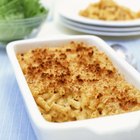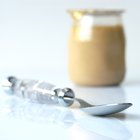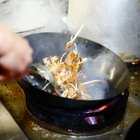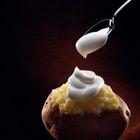
Whether you had a busy mom moment at the grocery store and missed picking up that carton of whipping cream, or you're looking to cut some fat out of your life, it can be tempting to use half-and-half in your favorite Alfredo or other creamy sauce. Unless you're willing to tread carefully, and possibly end up with a visually flawed final product, you might want to save the half-and-half for your morning coffee.
Know Your Creams
The fat in cream thickens sauce, adding a rich taste and smooth appearance. Many cooked sauce recipes call for creams with a high fat content, such as whipping cream or heavy whipping cream, which are 35 percent and 38 percent fat, respectively. On the other hand, half-and-half, made from a milk-and-cream mix, is the lightest of all cream products, with 10 1/2 percent to 18 percent fat. Recipes for beverages or cold soups often call for half-and-half, because of its light, liquid consistency.
Drawbacks
Half-and-half tends to separate and curdle, due to the lower fat content. Without sufficient fat to coat the proteins in dairy products, the proteins will clump together when exposed to heat. Although sauce that contains curdled half-and-half is generally safe to eat, if you follow all other standards regarding freshness and safe handling, it can make your sauce look unappetizing, because white flecks of curdled half-and-half will appear throughout your sauce. Additionally, a cooked sauce made with half-and-half will have a runnier texture than the same sauce made with whipping cream.
Solutions
If you're going to give half-and-half a go in your cooked sauce, it's important to use minimal heat once you've added the half-and-half. While whipping cream generally does well at a simmer, you should only warm half-and half as you whisk or stir it into the sauce. You may even remove the sauce from heat and add half-and-half as a final step before serving. Adding a few teaspoons of cornstarch, arrowroot powder or potato starch to the half-and-half before incorporating it into the sauce may prevent curdling, and it will also thicken the final product. If your sauce curdles despite these efforts, processing it in a blender immediately before serving can help salvage the appearance and texture.
Alternative
If you're out of whipping cream but don't want to risk a curdled sauce by substituting half-and -half, another option may lurk in your refrigerator. The Land 'O Lakes Test Kitchen recommends combining one part melted butter with two parts whole milk as an effective replacement for whipping cream.
Related Articles

Why Does a Sauce Curdle?

Can I Use Almond Milk for Alfredo Pasta ...

How Long Can You Refrigerate Nacho ...

Adding Half-and-Half to Thicken Soups

Low Sodium Substitute for Condensed ...

What Else Could You Use Besides Cream ...

Can You Make Chocolate Ganache Frosting ...

Can You Use Milk Instead of Cream for ...

How to Thicken Cream Filling

How to Fix Grainy Whipped Ganache

How to Freeze Yogurt Sauce

How to Use Buttermilk That Has Passed ...

Can You Make a Reduction Sauce From ...

How to Make a Cream Sauce With ...

How to Degrease Sauce
The Difference Between ...

Why Does Some Alcohol Curdle Cream?

What Can Be Used as a Substitute for ...

The Difference Between Half-and-Half ...

Can I Thicken Ganache With Powdered ...
References
Resources
Writer Bio
Marissa Meyer has been writing professionally since 2004, with work published on websites such as Decoded Science and MomSquawk. She has also worked in the travel, beauty, home design and childcare fields. Meyer received dual Bachelor of Arts degrees in communication and political science from University of Wisconsin-Green Bay.
Photo Credits
Ablestock.com/AbleStock.com/Getty Images